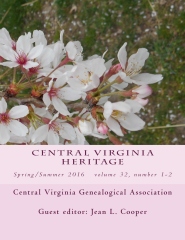1918 Pandemic, by Susan DuBar–Today’s pandemic has frequently been compared to the 1918 flu epidemic. I had a cousin who died in the epidemic at the age of six. I knew about her through photographs and frequent references to her in her mother’s and aunt’s conversations. She and my father were double first cousins and were constant playmates but I never thought to ask my father how her death affected him.
Also in my family was a maternal cousin, Earl, who was a small-town pharmacist during the 1918 epidemic. I learned only recently about him when I found a newspaper article (one of those “human interest” stories) my grandmother had preserved. It was interesting to learn how few medicines were available then….
To see the rest of this article, CVGA members should go to “Members Only” on the menu bar above, and choose “Central Virginia Heritage — Current Issue.” (Note: You have to be logged in to this website in order to see “Members Only.”)
If you have trouble logging in to the site to download your copy, please contact me at the webmaster link at the bottom of this page.
For those who are not members of CVGA, we offer the opportunity to purchase a printed copy of each issue. The Spring/Summer 2021 issue is available from Amazon.com at https://www.amazon.com/dp/B098WK24P1 for $6.50. Click on the Amazon.com link above or search for “Central Virginia Heritage” on Amazon.com.
Contents of the Spring/Summer 2021 issue:
- Try a New Approach for Genealogy Research During [the] Pandemic, by the Augusta (GA) Genealogical Society… page 1
- Original Versus Derivative, by Michael john Neill… page 2
- John Burnley vs. William Crenshaw, Louisa County, VA, 1801… page 3
- 1918 Pandemic, by Susan DuBar… page 4
- Marriage Announcements in the Daily Progress (Charlottesville, VA)
May-July 1895, transcribed by Diane Inman… page 5 - Division of the Slaves of Thomas Jackson, dec’d., Louisa County, VA
February, 1802… page 13 - Joel Parrish & Wife v. Executors of David Shepherd, et al.
Fluvanna County, Virginia, 1806-1808… page 15 - List of Amelia County (VA) Sheriffs, 1735-2021… page 17
- List of Greene County (VA) Sheriffs, 1838-2021… page 18
- List of Appomattox County (VA) Sheriffs, 1845-2021… page 19
- Cary Family (Virginia and Maryland) by Jean L. Cooper… page 20
- Charles William Cary (20 Sep 1826-23 Aug 1852), by Jean L. Cooper… page 22
- Estate of Elias Palmer, dec’d., Campbell County, VA, 1833-34… page 23
If you have any articles you’d like to share with CVGA members, please send an email to the editor, eleanordew at gmail dot com — The Editor.


